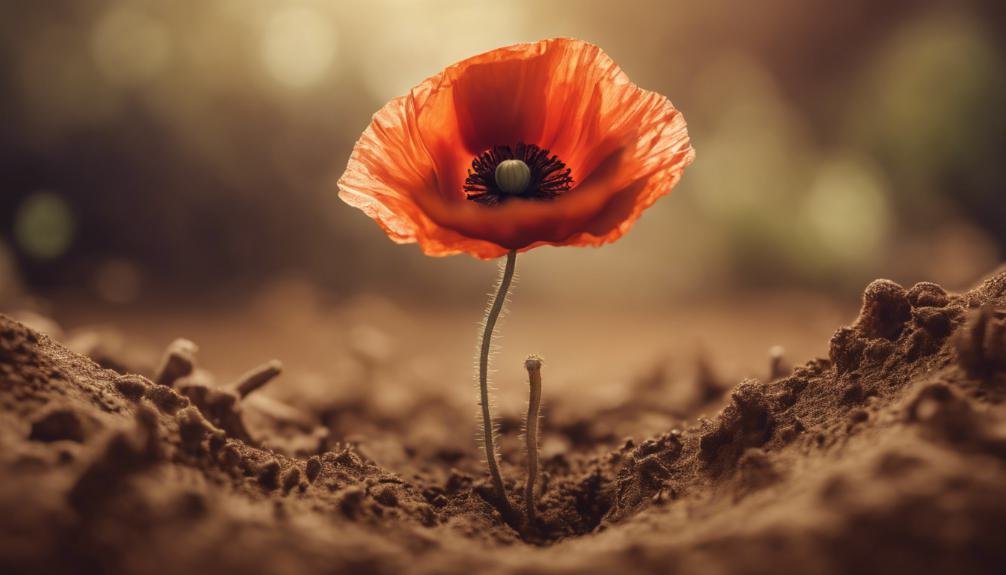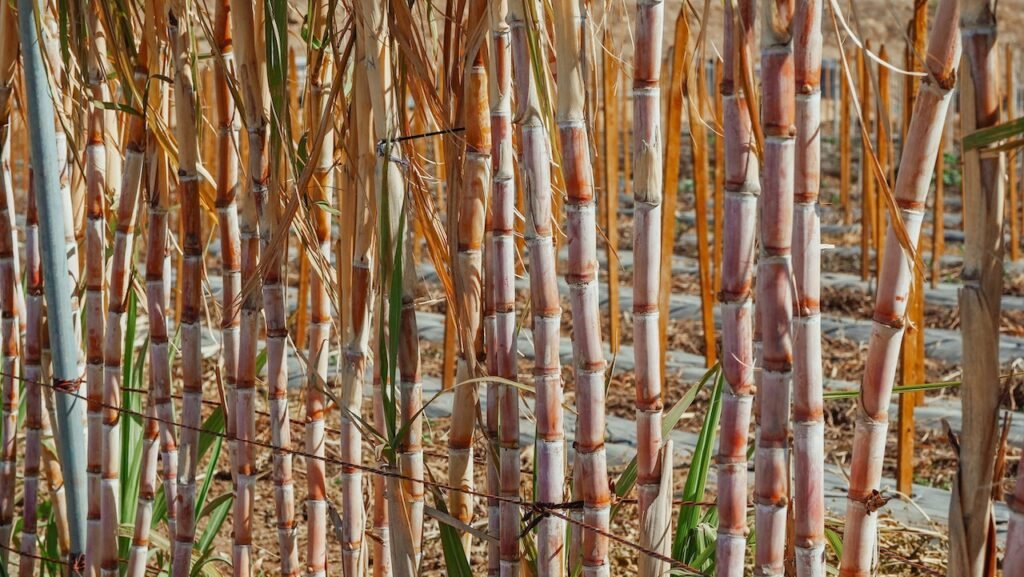You're wondering if poppies are perennial plants, and the answer is – it depends on the species. While some poppies complete their life cycle within a year, others take two years or more, and some can live for multiple years as perennials. With over 100 species of poppies, each has unique characteristics and growth habits. Perennial poppies require recognition and special care to thrive. By understanding the life cycle and needs of your specific poppy species, you'll be better equipped to provide the right environment for it to flourish. Now, discover the specific factors that impact poppy longevity and how to care for them over time.
Key Takeaways
- Poppies exhibit a mix of annual, biennial, and perennial growth habits, with some species living for multiple years.
- Perennial poppies can live for many years, while annual and biennial species complete their life cycle within a year or two.
- Recognizing the differences in poppy life cycles is crucial for effective cultivation and care.
- Some poppy species, like Papaver alpinum and Papaver orientale, are perennials that can live for multiple years with proper care.
- Proper care, including seasonal pruning and soil preparation, can help perennial poppies thrive and extend their lifespan.
Understanding Poppy Life Cycles

Understanding their life cycles becomes essential as you explore into the world of poppies, particularly since these plants exhibit a unique combination of annual, biennial, and perennial growth habits.
You'll discover that poppies have a rich history, with evidence of cultivation dating back to ancient civilizations. In fact, the opium poppy, Papaver somniferum, has been used for medicinal and ceremonial purposes for thousands of years.
In various cultures, poppies have been imbued with symbolic meanings. For instance, in Greek mythology, the poppy is associated with Hypnos, the god of sleep, while in modern times, it's often seen as a symbol of remembrance and honor.
Understanding these cultural connotations is essential to appreciating the complexity of poppy history.
You'll also find that the life cycle of poppies can vary greatly depending on the species. Some poppies complete their life cycle within a year, while others take two years or more.
Perennial poppies, on the other hand, can live for multiple years. Recognizing these differences is pivotal for effective cultivation and care.
Types of Poppies and Their Traits
You'll encounter over 100 species of poppies, each with unique characteristics, growth habits, and features that set them apart from one another.
Within the Papaver genus, you'll find varieties like Papaver rhoeas, Papaver somniferum, and Papaver orientale, each boasting distinct traits.
Papaver rhoeas, for instance, is an annual poppy with delicate, papery petals, while Papaver somniferum is an opium poppy with larger, more vibrant blooms.
Meconopsis characteristics are equally diverse, with some species sporting flowers in shades of blue, pink, and white.
Meconopsis grandis, also known as the Himalayan blue poppy, is a striking example, featuring large, sky-blue flowers with golden centers.
Other Meconopsis species, like Meconopsis cambrica, exhibit more delicate, nodding blooms in shades of pink and white.
As you explore the world of poppies, you'll discover a vast array of shapes, sizes, and colors.
From the dainty, cup-shaped flowers of Papaver alpinum to the statuesque, pillar-like stems of Papaver orientale, each species offers a unique perspective on the poppy's incredible adaptability and diversity.
How Poppies Grow and Multiply

As you explore how poppies grow and multiply, you'll discover that their seeds disperse far and wide, carried by the wind or other natural agents.
You'll also find that their roots spread deep into the soil, anchoring the plant and allowing it to absorb essential nutrients.
In addition, you'll notice that poppy stems produce more flowers and seeds, ensuring the continuation of the species.
Seeds Disperse Far
Poppies release their seeds into the air, allowing them to disperse far and wide, carried away by the slightest breeze. As you watch, the delicate seeds float effortlessly, carried by wind currents to new locations.
This phenomenon is known as wind dispersal, a vital mechanism for poppy propagation. The seeds' buoyancy, due to their light weight and air-filled cavities, enables them to travel considerable distances without settling.
As the seeds disperse, they're distributed randomly, increasing the chances of successful germination in new areas.
You'll notice that poppies often grow in clusters, an indication to the effectiveness of this dispersal method.
The wind dispersal mechanism also allows poppies to colonize new territories, rapidly expanding their range. By releasing seeds into the air, poppies guarantee their genetic material is spread far and wide, increasing their chances of survival and adaptation.
This remarkable strategy has contributed to the widespread distribution of poppy species, making them one of the most successful plant families in the world.
Roots Spread Deep
Frequently, the taproot of a poppy plant extends deep into the soil, anchoring itself firmly and allowing the plant to absorb essential nutrients and water. This deep anchorage enables the plant to withstand harsh weather conditions, such as strong winds and drought. As you observe the growth of a poppy plant, you'll notice that its roots spread deep, exploring the surrounding soil for resources.
| Root Structure | Function | Benefits |
|---|---|---|
| Taproot | Anchorage and absorption | Stability and nutrient uptake |
| Lateral roots | Exploration and spreading | Resource acquisition and territory expansion |
| Fine roots | Absorption and exchange | Efficient water and nutrient uptake |
Stems Produce More
During the growing season, you'll observe that the stems of a mature poppy plant produce multiple buds, which eventually develop into new stems, flowers, and leaves.
This process is vital for the plant's multiplication and spread. Each bud grows from a node, a joint where a leaf meets the stem.
Node development is a critical stage in poppy growth, as it allows the plant to produce new shoots and increase its overall biomass.
As the buds grow, you can encourage bushier growth by practicing stem pruning.
Cut back the stem just above a node, and the plant will respond by producing multiple new shoots from that point.
This technique not only promotes healthy growth but also increases the plant's chances of producing more flowers.
By understanding how poppy stems produce new growth, you can actively participate in the plant's multiplication process, leading to a more vibrant and lush display of flowers.
With proper care and pruning, your poppy plant will thrive and spread, providing a stunning display of color in your garden.
Factors Affecting Poppy Longevity
Environmental stressors, such as drought, extreme temperatures, and poor soil quality, can profoundly impact the lifespan of your poppy plants.
As you tend to your poppies, it's vital to examine the soil conditions in which they're growing. Poor drainage, compacted soil, or inadequate nutrients can weaken your plants, making them more susceptible to disease and pests.
Climate fluctuations, such as sudden frosts or heatwaves, can also affect poppy longevity. If you live in an area with erratic weather patterns, you may need to take extra precautions to protect your plants.
Additionally, you should monitor your poppies' response to environmental stressors. If you notice signs of distress, such as wilting or yellowing leaves, take action promptly.
Adjusting soil conditions, providing support, or pruning affected areas can help your poppies recover. By understanding the factors that influence poppy longevity, you'll be better equipped to take proactive measures to create a more hospitable environment for your plants.
Caring for Poppies Over Time

As you've taken steps to mitigate environmental stressors, you'll want to focus on providing ongoing care to guarantee your poppy plants continue to thrive over time. This includes regular maintenance tasks to certify maximum growth and health.
Seasonal pruning is essential, and should be done during the dormant season (winter or early spring) to promote healthy growth and encourage new blooms. Remove any dead or damaged stems, and cut back the plant to about 6 inches from the ground.
Soil preparation is also critical, and should be done annually. Add organic matter such as compost or manure to improve drainage and fertility. This will help support healthy root growth and promote robust plant development.
Monitoring for pests and diseases is a regular task that should not be overlooked. Regularly inspect your poppy plants for signs of pests or diseases, and take prompt action if you notice any issues. This will help prevent infestations and infections from taking hold and causing damage to your plants.
Planting and Propagating Poppies
To begin, prepare the soil by loosening it to a depth of about 12 inches.
Add a 2-inch layer of compost or well-rotted manure to improve drainage and fertility.
Next, select a container that provides good drainage and has a minimum depth of 6-8 inches.
You can directly sow poppy seeds in the container or start them indoors 6-8 weeks before the last frost.
Sow the seeds thinly and cover them with a thin layer of soil. Water gently but thoroughly.
For propagation, you can divide and replant established poppy clumps in the fall or early spring.
Make sure each division has at least one 'eye' or growing point.
Replant the divisions in well-prepared soil, watering thoroughly after planting.
With proper care, your poppies will thrive and provide a stunning display of color in your garden.
Frequently Asked Questions
Can I Grow Poppies in Containers or Pots Successfully?
Coincidentally, you're asking about container-grown poppies just as many gardeners are! You can grow poppies in containers or pots successfully, but be sure to choose a high-quality potting soil with good drainage to prevent waterlogged soil and root rot.
Are Poppy Flowers Safe for Pets to Be Around?
You should know that poppy flowers can be toxic to your furry friends, causing pet toxicity symptoms like vomiting, diarrhea, and lethargy if ingested; keep them out of reach to guarantee your pets' safety.
Do Poppies Attract Pollinators Like Bees and Butterflies?
You'll find that poppies attract pollinators like bees and butterflies, as they offer a rich source of nectar and pollen. Bees, in particular, prefer poppies' shallow flowers, which make it easy for them to collect pollen, highlighting the importance of pollinators in plant reproduction.
Can I Grow Poppies in Shady Areas or Full Sun Only?
You can grow poppies in partial shade to full sun, depending on the Poppy variety; most require well-draining soil with a pH between 6.0 and 7.0, but some tolerate shade and poorer soil requirements.
Are Poppy Seeds Safe for Human Consumption?
Can you imagine savoring a delicious poppy seed muffin without worrying about its safety? You shouldn't, as some people have poppy allergies, and culinary regulations vary; it is crucial to check local laws before consuming poppy seeds.


